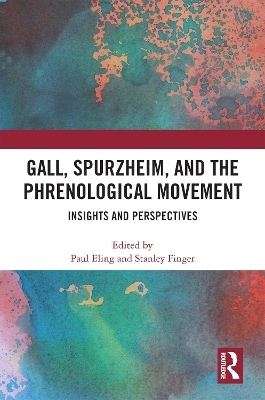
Gall, Spurzheim, and the Phrenological Movement
Routledge (Verlag)
978-0-367-49785-9 (ISBN)
During the 1790s in Vienna, German physician Franz Joseph Gall (1758-1828) came forth with a new doctrine dealing with mind, brain and behavior—one that could account for individual differences. He maintained that there are many independent faculties of mind, each associated with a separate part of the brain. He fine-tuned his ideas and published two sets of books presenting them after he and his assistant, Johann Gaspar Spurzheim, settled in Paris in 1807.
Gall's ideas had many supporters but were controversial and unsettling to others. In particular, the opposition ridiculed his belief that skull features reflect the growth of specific, underlying cortical organs, and hence correlate with personality traits (i.e., his ‘bumpology’). Gall’s fundamental ideas about the mind and organization of the brain were debated across the globe, and they also began to be exploited by unscrupulous businessmen, ‘professors’ who ‘read skulls’ for a living. But, as some historians have shown, his ideas about mind, brain and behavior led to the modern neurosciences.
The chapters collected in this volume provide new insights into Gall’s thinking and what Spurzheim did, and the faddish movement called ‘phrenology’, which originated as a science of humankind but became a popular source of entertainment. All chapters were originally published in various issues of the Journal of the History of the Neurosciences.
Paul Eling is Associate Professor Emeritus at the Radboud University, Nijmegen, the Netherlands. He published on a wide variety of topics in the field of cognitive neuropsychology and various textbooks. He is an Editor for the Journal of the History of the Neurosciences. Stanley Finger is Professor Emeritus at Washington University. He has published more than 250 articles and 20 books, including Franz Joseph Gall: Naturalist of the Mind, Visionary of the Brain (with Paul Eling in 2019). He was also an Editor for the Journal of the History of the Neurosciences.
Introduction
1. Gall, Spurzheim, and the Phrenological Movement
Paul Eling and Stanley Finger
2. Phrenology: Scheherazade of etymology
Régis Olry and Duane E. Haines
Overlooked Gall and Features of his Doctrine
3. Franz Joseph Gall on hemispheric symmetries
Paul Eling and Stanley Finger
4. Matters of Sex and Gender in F. J. Gall’s Organology: A Primary Approach
Tabea Cornel
5. Franz Joseph Gall on the "deaf and dumb" and the complexities of mind
Paul Eling and Stanley Finger
6. Gall’s German enemies
Paul Eling and Stanley Finger
7. An early description of Crouzon syndrome in a manuscript written in 1828 by Franz Joseph Gall
Stephan Heinrich Nolte, Werner Hansen, Paul Eling and Stanley Finger
8. "My God, here is the skull of a murderer!" Physical appearance and violent crime
Jaco Berveling
Spurzheim Reexamined
9. Johann Gaspar Spurzheim: The St. Paul of phrenology
John van Wyhe
10. The split between Gall and Spurzheim (1813–1818)
Harry Whitaker and Gonia Jarema
International Connections
11. The reception of Gall’s organology in early-nineteenth-century Vilnius
Eglė Sakalauskaitė-Juodeikienė, Paul Eling and Stanley Finger
12. Ludwig Heinrich Bojanus (1776–1827) on Gall’s craniognomic system, zoology, and comparative anatomy
Eglė Sakalauskaitė-Juodeikienė, Paul Eling and Stanley Finger
13. Matter over mind? The rise and fall of phrenology in nineteenth-century France
Marc Renneville
14. Franz Joseph Gall came to Copenhagen, and for a brief moment the brain was the talk of the town
Jacob Lauge Thomassen and Simon Beierholm
15. Gall’s Visit to The Netherlands
Paul Eling, Douwe Draaisma and Matthijs Conradi
16. Georg Büchner: Anatomist of the animal brain and the human mind
Michael Hagner
17. Phrenology as clinical neuroscience: how American academic physicians in the 1820s and 1830s used phrenological theory to understand neurological symptoms
Frank R. Freemon
18. The promotion of phrenology in New South Wales, 1830–1850, at the Sydney Mechanics School of Arts
Catherine E. Storey
Lampooning Phrenology
19. The phrenological illustrations of George Cruickshank (1792–1878): A satire on phrenology or human nature?
Gül A. Russell
20. Mark Twain’s phrenological experiment: Three renditions of his "small test"
Stanley Finger
21. Dr. Oliver Wendell Holmes on phrenology: Debunking a fad
Stanley Finger
| Erscheinungsdatum | 28.09.2023 |
|---|---|
| Verlagsort | London |
| Sprache | englisch |
| Maße | 174 x 246 mm |
| Gewicht | 453 g |
| Themenwelt | Geisteswissenschaften ► Psychologie ► Allgemeine Psychologie |
| Naturwissenschaften | |
| ISBN-10 | 0-367-49785-9 / 0367497859 |
| ISBN-13 | 978-0-367-49785-9 / 9780367497859 |
| Zustand | Neuware |
| Haben Sie eine Frage zum Produkt? |
aus dem Bereich


